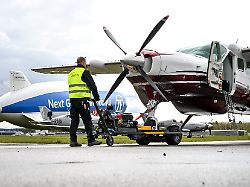According to a study, Germany’s shortest private flight route runs between Stuttgart and neighboring Böblingen. A single climate sin, no route in this country was more CO2-intensive in 2022. But something is strange: Böblingen has no airport at all.
Take the plane for a 15 kilometer route? At the end of March, one commissioned by Greenpeace caused study about the extent of climate-damaging private flights in Europe. It also prominently mentions “the shortest private flight route” in Germany. This runs between Stuttgart and the neighboring city of Böblingen with 50,000 inhabitants and should be 14.82 kilometers long. This makes it the most climate-damaging route in Germany. But something about that can’t be right.
What was the private flight study about? The Dutch consulting firm Delft compiled an overview of private flights and their emissions in Europe for Greenpeace. Delft used flight data from the company cirium were collected and processed. The background to the study is that private flights are real CO2 emitters: According to a other investigation 5 to 14 times higher than commercial flights and 50 times higher than train travel.
And the shorter a flight route, the more harmful it is to the climate. Because more fuel is consumed at the start, which drives up the average emissions per kilometer in the overall calculation. In the study, particularly short routes appear among the “top 10 routes with the highest CO2 intensity in 2022”. In fourth place was the route between Stuttgart and Böblingen.
Boeblingen has no airport at all
But there is something strange about the story: Böblingen has no airport or airfield. Although the city once had an airport, it has not been in operation since the 1950s. Residential and commercial buildings have been erected there since the early 2000s, and there is even a dedicated building for it website. When asked by ntv.de, the city of Böblingen was also unable to explain how the total of 18 flights from the study came about. “There is no runway, no runway. A lake has now been created where the runway used to be,” said a city spokesman to ntv.de.
When asked by Greenpeace, ntv.de initially said: Böblingen still has an IATA code, the three-digit airport abbreviation that is known from baggage tags when checking in. Since the aircraft on the Stuttgart-Böblingen route are all small C208 turboprop aircraft, a spokesman for Greenpeace European Unit writes, it is “quite possible that they take off here or nearby and that the transponders connect planes to PHM (Böblingen) airport”.
Delft publishes correction
But where these planes take off and land remains a mystery. The nearest airfields are miles away. Has the Mercedes plant in neighboring Sindelfingen, which borders the former Boeblingen Airport, have anything to do with it? When asked by ntv.de, there was no answer from the carmaker so far.
After all, the makers of the study are drawing conclusions from the previously unexplained short flight after the ntv.de request and are publishing one correction: “Following the publication of the report, we were made aware that one of the airports mentioned in the report, Böblingen in Germany, is no longer in operation,” it says. This means that the shortest route in Germany in 2022 will not be 15 kilometers. This title goes to the route from Friedrichshafen to Altenrhein in Switzerland – a flight of just 22 kilometers across Lake Constance.
Small routes not all checked
But how could the Böblingen breakdown happen? Greenpeace admitted to ntv.de that not all of the shortest routes in the study had been checked in detail: “In our checks, we are concentrating on the most important results of the report,” including the most common routes and busiest airports. “The data provider Cirium is currently investigating why these flights were assigned to Boeblingen Airport and where they took off from instead,” Delft’s correction reads.
Delft also emphasizes that the 18 flights on the ominous Stuttgart-Böblingen route in 2022 were of little consequence given the total of 58,424 flights that departed from German airports. The influence of the Böblingen flights on CO2 emissions is also “negligible”. According to the study, the private flights recorded for 2022 caused almost 3.4 million tons of CO2 emissions – which corresponds to the annual amount of more than half a million EU residents.
